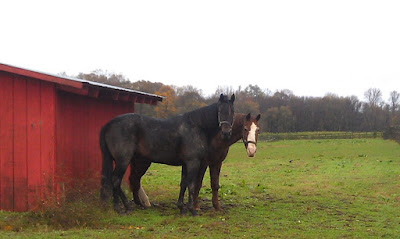I am sure that the last couple of weeks have been a
challenge for all of us here in New Jersey and surrounding areas. In the wake
of the two severe storms, there is even MORE work to be done now in the home
and in the pasture.
After the first storm, my gal pal Christi and I emerged from
our run-in shed and took a tentative walk around our field. The ground was soft
from the heavy rain, and she couldn’t resist the urge to plop down and take a
glorious dirt-bath. I couldn’t let her have all of the fun without me, so I decided
to dive right in too! What horse doesn’t
love a good romp in the mud! While closer to the ground, I was able to see things
from a different perspective, like a worm’s eye view. I noticed immediately
that the paddock was covered in a more-than-usual coating of aged leaves. This
got me a little worried because certain trees and their leaves may be toxic
which can severely affect the health and well-being of horses. Leaves may look
pretty, but they can pack a punch for horses.
If you recall, my last post, Pruning
Out Poisonous Plants, was on this precise topic. It’s such an important issue; I thought I’d
recap it for you!
 |
| Chrisiti and Nelson after a romp and roll in the field |
Before Superstorm Sandy, I posted about the encroachment of
pesky plants in pastures. Now, it is more important than ever to familiarize
yourself with trees and shrubs that are toxic to horses. In the wake of Sandy’s
winds and last week’s Nor’easter, many leaves and branches have been whipped
far and wide. And that includes a tasty spread on fields, which horses may
feast on! This is not only a problem because they will ruin their Thanksgiving
appetite, but because if they do happen to eat any of these toxic leaves, they
might be too sick to even look at their Thanksgiving buffet. It
is essential that you pull out those muck buckets and leaf blowers and replace
a potentially deadly leafy snack with a healthier one.
Below are some leaves that you don't want to find around your fields. Some key things to look for:
-
Plants with berries (especially the dark blue
ones, which indicate Nightshade, a deadly plant)- Three-point leaves (some of these are maple leaves, another toxic plant)
- Leaves from (or potentially near) skyscraping Oak trees
- Trees with hard, rough-surfaced, ball-shaped fruits (indicative of Black Walnut or Buckeye Tree)
Refer back to my last
blog post for a full list of deadly desserts and ways to identify them. This
challenge is at least one that we have more control over this time and I urge
you to take control of your fields and horse-proof them as soon as possible!
One more thing!
Superstorm Sandy may have been wicked but my super smart friends at the
Equine Science Center were making sure you would be ready. They created an Emergency
Preparedness webpage on their website with lots of important safety and awareness
resources for fellow horse owners just like you! Make sure you bookmark this page NOW so
you’ll have all the horse safety info you need BEFORE the next storm!
Stay Safe & Happy Raking,
Lord Nelson

No comments:
Post a Comment